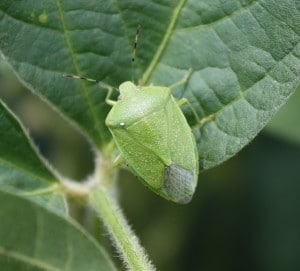I ran a similar article last year. Normally, stink bug infestations are worse in later planted soybean. They serve as a sink for bugs when other crops are maturing, and overall population levels have had all summer to build. However, we sometimes see high populations of adult stink bugs in soybean fields that are unusually early in maturity compared with other fields in the area. Soybean is a preferred host for green stink bug, and early maturing fields can serve as a trap crop, sucking in bugs from a wide area.

The moral of this story is to scout for stink bugs in these early maturing fields. In some cases, spraying early maturing fields can take out a high percentage of stink bugs in the vicinity. Often, what we see is a spike of adult stink bugs in early maturing fields, then populations mysteriously subside as they disperse into later fields.
- The treatment threshold for stink bugs during flowering and podfill (R1 – R6) is an average of 9/25 sweeps. I often suggest you can ‘ride’ infestations that are just above threshold in fields that are at R1 or R2 stages of development. This level of stink bugs can’t really hurt yield because there is not any seed for them to feed upon until you hit R3. Thus, you can afford to wait and potentially delay an insecticide spray until a fungicide is being applied (or even later).
- Most pyrethroid insecticides work very well on green stink bug, which typically composes the vast majority of the population in Tennessee. However, specifically use bifenthrin (e.g., Brigade, Sniper, Fanfare, Discipline) or Acephate if 20-30% or more of the population is composed of brown stink bugs.
Just FYI – You can see a white egg on the back of the stink bug pictured above. This is the egg of a tachinid fly, Trichopoda pennipes, a common parasitoid of adult stink bugs and large nymphs. We saw one or more of these eggs on virtually every stink bug at one of our scout school locations last week. The egg hatches, the larva burrows into the stink bug, and emerges later to pupate. Ultimately, this kills the host and can greatly reduce the egg-laying ability of females. It takes a little time, and parasitized females may lay some or most of their eggs before the parasitoid really does its business.

